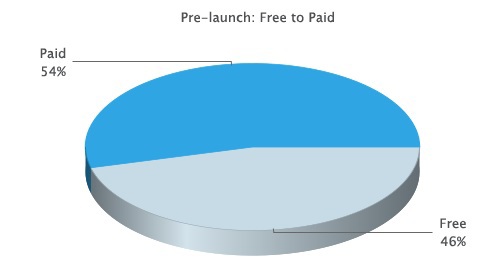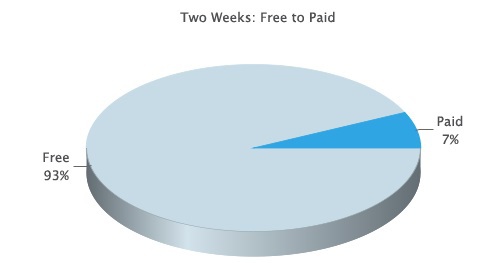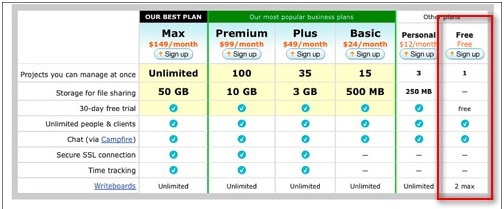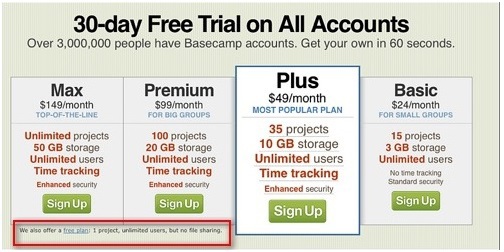Why shouldn't the software be free?
 The trial period of using the service, many projects provide their users for free. Recently, this strategy has gained immense popularity. Everyone knows the success stories of services such as MailChimp or Pandora, but they forget about many other “not shot” startups with the same model. For every start-up entrepreneur, choosing a business model and its impact on conversion is extremely important. In this regard, we want to share the experience of the creator of the software for designers Bidsketch Ruben Gamez, which shows the low efficiency of free versions for business. The article is written in the first person.
The trial period of using the service, many projects provide their users for free. Recently, this strategy has gained immense popularity. Everyone knows the success stories of services such as MailChimp or Pandora, but they forget about many other “not shot” startups with the same model. For every start-up entrepreneur, choosing a business model and its impact on conversion is extremely important. In this regard, we want to share the experience of the creator of the software for designers Bidsketch Ruben Gamez, which shows the low efficiency of free versions for business. The article is written in the first person.Not so long ago, the manufacturers of each product necessarily offered some type of free tariff plan. This strategy worked great: get a huge number of free users, and in the end turn them into paying customers. Everywhere you look, everything was full of stories, as entrepreneurs quickly and easily earned huge sums of money using this approach.
When 37signals talked about providing something for free, as part of a special marketing strategy, it seemed reasonable to me:
“We made the Writeboard and Ta-da list applications completely free to use to attract audiences to our other products. In addition, we always offer a version of the free version for all of our applications. We want people to familiarize themselves with our product, its interface, to realize the benefits of what we have created. As soon as our users are hooked, there is much more chance that they will switch to one of the paid tariff plans (which give access to more projects or pages, provide people with additional features, such as the ability to download files and encrypt data via SSL) ".
')
So when I launched Bidsketch , a SaaS application for designers, it seemed like an obvious necessity to create a free version. Whether I needed it or not, I almost did not think, it seemed to me that it goes without saying. At first, everything went quite well. During the first few days after the launch of the project, the number of customers who purchased the paid version was even more than the number of free users.
“Damn it, the idea of a free tariff plan really works,” I thought. You can look at the numbers: 54% of users paid for the product, and only 46% settled on the free version.

It looked great, but I suspected that this situation would not last long, because most of the buyers were from my mailing list. A quality list of users for whom you are mailing, as a rule, is converted much more buyers compared to other sources of traffic.
A week later, I was still satisfied with the result, until I decided to calculate the conversion of the total site traffic.
After 2 weeks, the ratio of users of free and paid versions: 93% versus 7%.

I understood that this would not work in the long run, because I relied on the effect of a paid data plan for a limited time. But I could not even imagine how much worse things would go:
After 6 weeks: free version - 99%, paid - 1%.

Next month, only 1% of users preferred the paid version. My user base was growing rapidly, but there was barely enough money. It became increasingly difficult to maintain the product due to the growing user base, and the thought of what would happen in six months did not give me rest.
How many users of the free version have I been able to turn into paying customers? In my case, the result was an extremely modest figure of 0.8%.
When things began to go really bad, I realized my mistake. I simply selected not those options in a paid functionality. Or, perhaps, messages suggesting a transition to the paid version were not timely and inconclusive.
To convert users of the free version into buyers, I used many tactics:
• More reminders about the update functionality;
• Fewer options in the free version;
• The premium version is free for 15 days;
• More letters offering to purchase the paid version, etc.
None of these tactics brought the desired result. My income remained at the same extremely low level, despite the fact that my user base was growing rapidly.
If I continued on this path, then soon I would have thousands of users of the free version of the product who need to be serviced.
In a desperate attempt to finally start moving in the right direction, I experimented with the tariffs, destroying the free version. I did not advertise the transition to paid tariffs anywhere, but simply removed the opportunity to activate the free version from the page of the site where the tariff plans were indicated.
Most of all, I was afraid that the number of paying customers would remain the same, but I would lose all users of the free version. Which means the loss of the list of users who can at least try to sell the paid version of the application in my mailing list. Not that it worked well for me, but at least it was at least something.
The result was not at all the way I expected. The change I made (which took 5 minutes from the force) led to an increase in the number of paying customers by 8 times.
We are talking about an increase in conversion not by 8%, but by 800%.
The results seemed more than satisfactory to me, and I continued to monitor the conversion rate for a month. This is amazing, but this month the number of paying users has increased 10 times.
And my situation is far from an exception.
It took quite some time after I got rid of the free version, and I began to notice that many have the same problems with the use of the free data plan.
For example, 37signals also removed their free version from the tariff plan page.
Before:

After:

Soon after, I came across an interview with the founder of 37signals, Jason Fried, in which he talks about their free tariff plan:
“... The main part of the income from our products comes from users who immediately pay for using the service for a period in advance. Of course, some users switch from the free version to the paid version, but most of the paying customers have chosen the advanced version from the very beginning. We can say with confidence that many more people will always use the free version, but if your goal is paying customers, then ask to pay for using the service in advance, and you will have much more chances to earn. ”
The so-called success stories of the freemium monetization model are also characterized by a low percentage of transition from free to paid accounts. You can bring statistics about Pandora, Evernote and MailChimp, which confirms this trend.
Pandora developers started with less than 1% of paying users relative to the total subscriber base. When they focused on improving the premium version of the product, this figure increased to 1.7%. This figure is absolutely not impressive, except that your service is used by 20 million users, as is the case with Pandora. The authors of Evernote started with a conversion rate of 0.5% and were able to achieve an increase of only up to 2% per year.
While MailChimp did not publish their conversion rates, they simply shifted the negative focus on side effects:
“What grows most when you launch the free version? The number of spam increased by 354%, and the legal costs associated with attempts to hack the system by 245%. ”
Oh my God. Where was this information when I needed it?
CrazyEgg decided to suspend support for the free version in January 2009, and so it never returned.
Here is what their new tariff plans look like:

I asked the founder of CrazyEgg Hiten Shah why they decided to abandon this idea. “We thought that if we removed the free tariff plan, we would be able to earn more,” says Khiten. And they were convinced of the correctness of their decision, having doubled their income twice during the same month.
The co-founder of LessAccounting, Allan Branch, believes that because of the lack of information about which approach to the free versions is correct, they simply do not see any reason to change their course. Their users have the opportunity to evaluate the merits of the paid tariff during the trial period, and if they do not enter the data for payment at the end, they will automatically be switched to the free version of the product with limited capabilities. Obviously, this approach works for their service.
An example to be equal to
Many of us are far from the level of these guys: we are not dealing with millions of users, and not even with hundreds of thousands. Therefore, it is easier for us to look at some example of the type Pluggio .
Pluggio is a freemium Twitter app created by Justin Vincent. He had detailed statistics in which everything was reflected: from monthly revenue to the number of users using each type of tariff.
Screenshot of the statistics page:

On average, since November last year, he earned about a thousand dollars a month. Unlike examples with more famous products, the number of paying users is 2.5% of the total number of accounts. This is damn good for any freemium application, judging by the statistics that we have reviewed earlier.
I talked to Justin to share his experience with the freemium model. It seemed to me that things were going well with Pluggio, so I was genuinely surprised when he told me about his intention to remove the free version of the application from access.
Why did he decide to do this? Revenues have become relatively stable, and the number of users has increased significantly over the past few months (and close to 5 thousand). This speaks of the many pitfalls that entrepreneurs with limited resources encounter when they get the free version.
Does it make sense to create a free version at all?
I do not presume to say that it is impossible to achieve success if you start up with a free data plan. Obviously, free tariff plans worked perfectly for companies like Wufoo, MailChimp and Freshbooks, thanks to them we know that this can work efficiently. But the problem is that we are not these guys.
We must stop blindly copying the tactics of large companies and start thinking about how to increase our income.
I recognize that there are certain types of applications that are more likely to succeed if free tariff plans are available to their users or they operate according to the freemium model. But the vast majority of applications do not fall into this category, and most people do not have so many resources to make this model work.
To succeed due to the word of mouth effect, you need a lot more users than many of us are able to attract. Instead, we end up with a large number of users of the free version, who spend our resources and do not give anything in return. To top it off, most of them will never switch to paid rates.
If we have thousands of users who do not increase product awareness and are not going to pay for it ever, then why do we continue to offer them something that is ruining our business? Maybe we should just let go of the idea with the free version, and instead focus on making money.
Source: www.softwarebyrob.com/2010/08/18/why-free-plans-dont-work
Source: https://habr.com/ru/post/233877/
All Articles